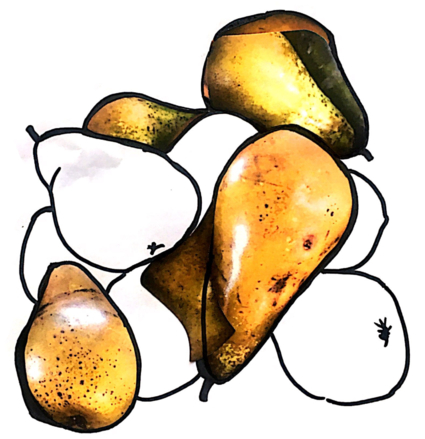This is a two fermentations vinegar. To make it you will need...
Ingredients:
- 2 kilos of ripe pears
- Liquid Yeast: I chose english cider yeast. About 17,5 gr. for two kilos of pears.
Equipment:
- 1 Immersion blender
- 5 liter food safe bucket
- 1 Air lock (for the bucket)
- Cheese cloth
- 1 Mason Jar
Procedure:
Summarized
Take pears and blend them down until no big chunks are visible. To this puree add the yeast and stir. Place this mixture in a food safe bucket that leaves about 15% of the space free. Close the bucket with an airlock.
Let the mixture ferment at 20-30ºC for approximately 10 days. Check on it almost daily, mixing and tasting it. After the mentioned days have passed, strain the mixture, heat the liquid up to 75ºC and keep it at that temperature for 15 minutes. Let it cool down a little and then add 8% of unpasteurized vinegar and mix. Place the aerator in and let it oxidize for about 10 to 15 days.
Step by step
1. Start off by cutting down the pears into smaller chunks; using the immersion blender, blend the pears until you cannot see any big pieces; it does not have to be a smooth liquid.
2. Add 17,5 gr. of liquid yeast. Follow the directions of the package for proper use. We used "white labs pure pitch", a brand that indicates to let the temperature of the yeast go up to approximately 21 degrees before using.
Add the yeast into the pear puree and mix. Pour in the bucket, close and place airlock; if you dont have one, you can close it by simply placing the bucket's lid on it, without actually pressing, this way the C02 will be able to get out.
Let it ferment between 20 to 30 degrees and for 7 to 10 days. I allowed mine to ferment for 8 days. Check and mix daily, always introducing clean equipment to avoid contamination.
Checking daily will allow you to see how much the mix changes; the yeast eat up the pear and really break it down. The videos below show part of the process my pears underwent.
After one day...
A thick layer of pear was created at the top. The part that was exposed to oxygen presented clear oxidation based on its color. When mixed, bubbles started appearing. Smell and taste remained true to the original taste.
After 3 days...
The top layer had lost thickness. Started smelling like... a ferment? Similar to when you accidentally leave a natural orange juice out in the warmth for too long.
3. After 8 fermentation days, the mix was strained and heated up to 75ºC. The temperature was kept track of using a thermometer and controlled by playing with the pot's exposure to the hear source. (I basically was taking the pot off when it started getting too warm and putting back when the temperature was dropping too much)